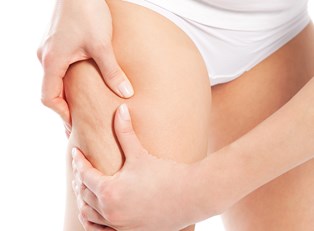Stretch marks, or striae, are an unfortunate side effect of pregnancy that probably won’t ever go away completely. About half of women develop stretch marks at some time throughout pregnancy, although the darker your skin the less noticeable they’ll be. Striae can begin as early as 13 weeks, or it may be farther into your pregnancy. Essentially, your baby is growing so fast that your skin is spreading faster than its prepared for, literally creating tiny tears. If your mother got stretch marks, you’re probably destined for them too, but there are a few things you can do to minimize their appearance.
Watch Your Weight Gain
Anything that makes your skin grow even faster is going to increase the appearance of stretch marks. While your skin does have a lot of elasticity to it, there are still some limits to this elasticity. A sudden change in weight, such as pregnancy, can exceed your skin's ability to stretch. This doesn’t just mean fat—if pregnancy strikes an urge to get really buff, muscle mass can have the same effect.
Managing your weight during pregnancy can help a lot. If you put on a lot of weight early, your body is already trying to stretch out to keep up.
Moisturizers Early and Often
A high-quality skin moisturizer can help prevent stretch marks, particularly by minimizing them so that they heal and fade more easily. Use a skin care product designed specifically for stretch marks—but do your research, because there are a lot of bunk products. Moisturizers with Vitamin E or cocoa butter tend to work well for many moms. There is no reason to wait until they appear to start acting preventatively—get a good lotion early in your pregnancy, and use it daily from the start. It’s easier to prevent than it is to heal. If you’re already noticing stretch marks, start using your lotion on areas where you see them forming (or where you notice an increase in bulk). A good massage can also increase the blood flow to the area, another helpful means of prevention.
Mind Your Diet and Hydration
Eating healthy and well is a significant aspect of pregnancy, and it can vicariously help keep stretch marks at bay, too. Yes, you’re eating for two, but one of those two weighs less than five pounds and sleeps pretty much all day. The ideal caloric increase is about 300 calories a day. Talk to your doctor about how much weight you should gain while you are pregnant. With all those extra fluids flowing around, hydration is extremely important too. And it will continue to be if you choose to breastfeed, so get into the habit of drinking twice as much water as a normal person—despite your constant urge to pee. The hydration will keep your skin pliable and hydrated, minimizing the appearance of stretch marks.
Take Prenatal Vitamins
While you’re at it, start taking prenatal vitamins (even if you’re just in the planning stages, start taking them anyway). Your body is going to need extra vitamins throughout your pregnancy (and it can help with conception), which is why it is important to make sure you take your prenatal vitamins. The baby gets first dibs on any vitamins and nutrients that come through your body, and you get the leftovers. Prenatal vitamins can also help make sure you get enough of all those important things that keep your hair and skin pretty and shiny.
Avoid Tanning and the Sun
Even though fair skin makes stretch marks more obvious and likely, tanning isn’t going to help. Avoid tanning, either in the sun or a tanning bed, while you are pregnant, especially if you are concerned about developing stretch marks. Tanning can dry your skin out and reduce its elasticity, thus increasing your likelihood of developing stretch marks. This should not be entirely surprising, given that UV rays prematurely age the skin and cause early wrinkles.



